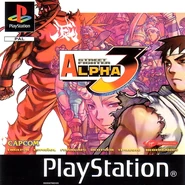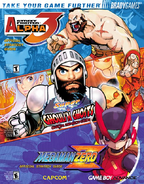Street Fighter Alpha 3, known as Street Fighter Zero 3 (ストリートファイターZERO 3, Sutorito Faita Zero 3?) in Japan and Asia, is a 1998 fighting game by Capcom originally released for the CPS II arcade hardware.thumb|300px|right|Alpha 3 Intro and Demo Mode It is the third game in the Street Fighter Alpha series, following Street Fighter Alpha: Warriors' Dreams and Street Fighter Alpha 2. The gameplay system from the previous Alpha games was given a complete overhaul with the addition of three selectable fighting styles based on Street Fighter Alpha (A-ism), Street Fighter Alpha 2 (V-ism), and Super Street Fighter II Turbo (X-ism), new stages, a much larger roster of characters, and for the first time since the original Street Fighter II, new theme music for all the returning characters.
Characters
Returning Roster
- Adon
- Akuma
- Birdie
- Chun-Li
- Ken Masters
- M. Bison
- Ryu
- Sagat
- Charlie
- Dan
- Guy
- Rose
- Sodom
- Dhalsim
- Evil Ryu
- Gen
- Rolento
- Sakura
- Shin Akuma
- Zangief
Introduced/Added
Home Console Versions Only
Portable Versions Only
Cameos
Versions
Street Fighter Alpha 3 was initially ported in 1998 for the PlayStation. T. Hawk, Fei Long, and Dee Jay, the remaining "New Challengers" from Super Street Fighter II, who were not in the original arcade version, were added to the roster. Balrog, Juni, and Juli were also added to the immediate roster, after they were given new character portraits and their own storylines. Evil Ryu, Shin Akuma, and Guile were also added as secret characters in the World Tour mode, a mode that allows players to customize their chosen character's fighting style. An additional feature in the Japanese version also made use of the PocketStation peripheral, which allows players to build up their character's strength. In this version, Shin Akuma serves as the final boss for Evil Ryu. Due to RAM limitation, the only unique pairings available in the Dramatic Battle Mode are Ryu & Ken or Juni & Juli.
The 1999 Dreamcast version, titled Street Fighter Alpha 3: Saikyo Dojo (or Street Fighter Zero 3: Saikyō-ryū Dōjō in Japan), retains all the added features from the PlayStation version of the game. An online mode was added that allowed players to display their high scores. In addition, a Saikyo Dojo mode was added which pits a very weak character of the player's choice against two very strong opponents. This Dreamcast port was re-released in Japan in 2000 as Street Fighter Zero 3: Saikyō-ryū Dōjō for Matching Service, which was released as a mail order title via Dreamcast Direct. The Matching Service version differs from the original due to the addition of an Online Versus Mode.
A Sega Saturn version of Street Fighter Zero 3 was also released in 1999 shortly after the initial Dreamcast version in Japan only. The Saturn port makes use of Capcom's 4-Mega RAM cart and utilized all of the features added to the PlayStation version. However, the extra RAM was used to include more frames of animation and much shorter loading times than the PlayStation version, making it a near arcade perfect port. Evil Ryu, Shin Akuma and Guile are immediately selectable. While the World Tour and Survival modes are virtually unchanged from the PlayStation version, Dramatic Battle received major improvements with the addition of Reverse Dramatic Battle and allowed three different characters to be used. Also, this port is the only one to feature dramatic battle against the entire roster of characters. All other versions limit dramatic battle to boss characters.
Street Fighter Alpha MAX
Street Fighter Zero 3 was re-released for the arcades in Japan in 2001 under the title of Street Fighter Zero 3 Upper, officially promoted as Street Fighter Zero 3↑. The game was released for the Dreamcast-based NAOMI hardware rather than the original game's CPS II hardware and features all the added characters from the console versions of the game. Upper also allows player to upload any customized characters from the Dreamcast version of the game by inserting a VMU into a memory card slot on the cabinet.
A Game Boy Advance version developed by Crawfish Interactive was released in 2002. The GBA version is titled Street Fighter Alpha 3 Upper on the title screen. The port is compressed and lacks several stages and music from the previous arcade and console versions, although all characters were present. In addition, Eagle, Maki and Yun and Yang, all whom were characters from Capcom vs. SNK 2, were added to the game. Only a small amount of character voices were ported over to this version and the developers raised Ken's voice to a higher pitch and used it as Sakura's voice.
The PlayStation Portable version, titled Street Fighter Alpha 3 MAX, Street Fighter Zero 3 Double Upper in Japan, officially promoted as Street Fighter Zero 3↑↑, was released in 2006 and features the additional characters from the GBA version as well as Ingrid from Capcom Fighting Evolution. The game is a near faithful port of the arcade version with minimal loading times and all graphics intact. All the added characters now feature their own in-game storylines and endings.
Street Fighter Alpha Anthology
Street Fighter Alpha Anthology (Street Fighter Zero: Fighters' Generation in Japan) was also released in 2006 for the PlayStation 2. It contains the arcade version of Alpha 3 as one of the immediately available games, along with a revised version of Alpha 3 Upper as a secret game. The World Tour Mode that was featured in the previous home versions is not included in this compilation, nor the extra characters introduced in the portable versions of the game.














